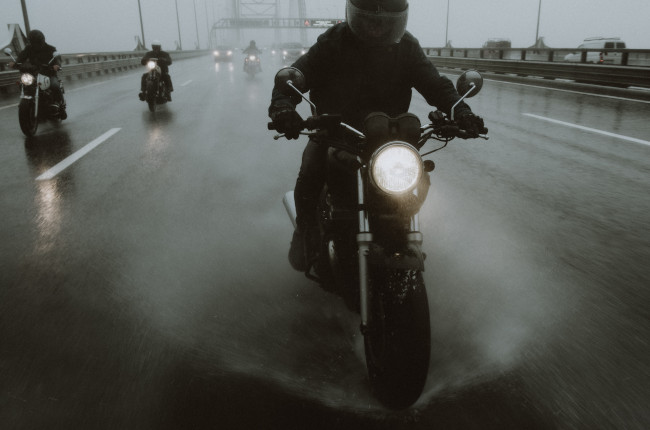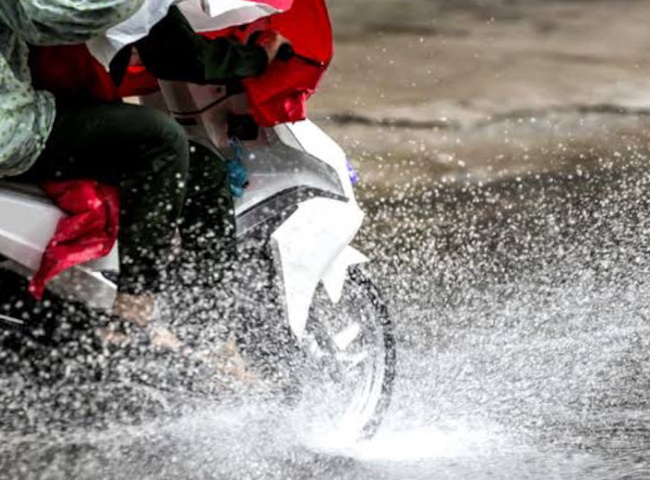How to safely ride your motorcycle on wet and uneven road surfaces
Do you still ride your motorcycle even when it’s raining?

For commuters on two wheels, the wet season may be disastrous. Because precipitation pulls all the oil, muck, and soot to the surface, freshly-precipitated asphalt has a tendency to be exceedingly slippery. A motorcyclist who is not prepared may become disoriented if it suddenly starts to rain. Not to mention the threat to safety that halting beneath an overpass in the midst of moving traffic entails.
When it rains, it pours, as the phrase goes. Rainwater not only makes the roadways slick, but it also hastens the wear and damage caused by passing cars. The notoriously bad quality of Metro Manila's roadways has long been a problem, and it becomes worse when it rains. Puddles may very easily hide large potholes that damage the rims, or even worse, open manholes that might cost you a lot of money in repairs or worse. Preparation is essential while riding a motorbike in the rain, as is obvious. Here are some pointers to help you get ready and keep you secure when riding in the rain.
Think several steps ahead

Preparation is vital, as it is in all weather situations. Experienced riders are able to foresee events accurately seconds before they really occur. Having a keen sense of anticipation is essential when riding in rainy weather since the wet road surface significantly reduces our tires' ability to turn and stop the bike.
Planning your routes and your day's supplies in advance is another example of thinking ahead. While you get up in the morning, it can appear clear and sunny, but when you're getting ready to go home in the evening, it might start pouring down rain. Before leaving the house, check the weather app on your phone so you can determine whether to bring additional clothing or use your waterproof gear all day. Avoid puddles on the road and routes that are prone to flooding.
Look after your motorcycle’s maintenance

Our primary concern should be to keep your motorcycle rubber side down, especially throughout the wet season. In damp conditions, many mechanical gremlins come to light. Allowing mud and filth to accumulate on your bike and not washing it for days or even weeks out of complacency just makes things worse.
Be careful to maintain proper levels of the important fluids required for your bike's efficient operation. Brake pads, brake fluid, and tire wear should all always be above the recommended levels. Even while it's awful enough when your bike breaks down in good weather, it's far worse when it happens during a heavy downpour. Naturally, it is essential to make sure your motorbike is in good condition as well, regardless of the weather.
Don't skimp on safety gear

It might be quite tempting to forgo essential safety equipment in favor of comfort, especially when it's raining. It appears more convenient to wear slippers instead of closed shoes and shorts rather than pants to avoid the inconvenience of having to deal with these items being wet.
However, the likelihood of an accident is much higher in the rain since the road surface offers less traction and the reduced visibility makes anticipating hazards more difficult. This implies that you are more likely to lose control of your motorcycle, overshoot a turn, crash into another vehicle, or low side a curve. Given the large difference in probability, you would undoubtedly want to be better prepared.
See and be seen

You and the other drivers on the road have far less visibility when it rains. It is your duty as a rider to make sure you can see and can be seen. Given that the majority of prudent riders would always wear a helmet when riding a motorbike, it can be helpful to apply a coating of hydrophobic wax to the face shield or, if one is available, to buy a pin-lock visor for your helmet.
Water droplets won't stick to your visor and obstruct your vision if you apply a hydrophobic wax coating to it. As a result, it keeps your vision clean by allowing these water droplets to effortlessly slip off. A pin-lock visor, on the other hand, creates a little air pocket between the warmer interior of the helmet and the cooler exterior to keep your visor from fogging up. Additionally, it's crucial to be visible to other drivers. Make sure your vest or jacket includes reflective spots or sections, and stay away from dull, matte colors.
Related Articles
-
Last-minute Christmas gift ideas for your rider friends and family / Featured Article
Struggling to think of gift ideas for your motorcyclist friends and family? Read on to get some inspiration this gift-giving season.
-
Motorcycle 101: The inner workings of a slipper clutch / Featured Article
Slipper clutches are awesome as they make for more forgiving downshifts and a lighter clutch lever. Let’s take a closer look at them and see how they work.
-
5 things to remember when shopping for new motorcycle tires / Featured Article
Here are 5 things to consider when time comes for you to replace the tires on your motorcycle.
-
4 bike-packing hacks for long adventures / Featured Article
Here are a few tips and tricks when it comes to packing for multi-day trips on your motorcycle
-
Tips and tricks for long-distance riders / Featured Article
Follow these tips and tricks when getting ready for a long-distance ride on your motorcycle.
Latest Features
-
Last-minute Christmas gift ideas for your rider friends and family / Featured Article
Struggling to think of gift ideas for your motorcyclist friends and family? Read on to get some inspiration this gift-giving season.
-
Ride a naked sportbike? Get these 5 upgrades first / Featured Article
Here’s a quick list of 5 upgrades to your naked sportbike to enhance your riding experience.
-
Motorcycle 101: The inner workings of a slipper clutch / Featured Article
Slipper clutches are awesome as they make for more forgiving downshifts and a lighter clutch lever. Let’s take a closer look at them and see how they work.







